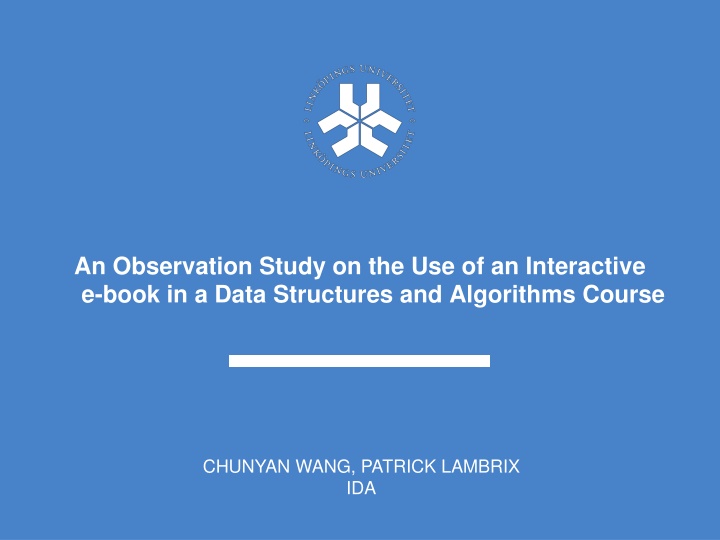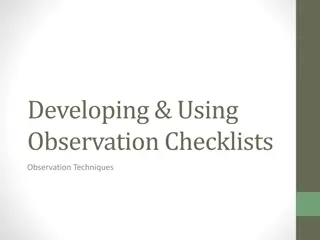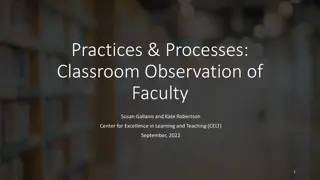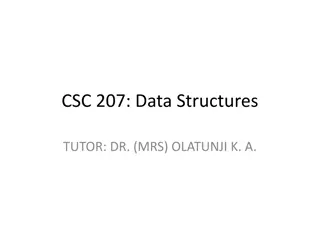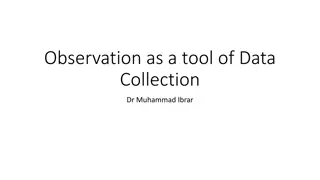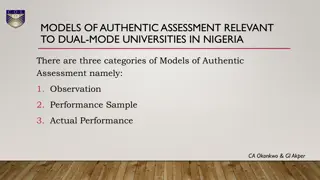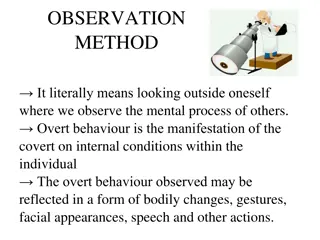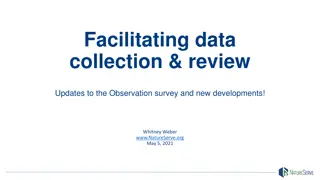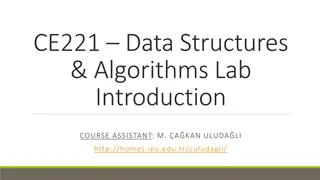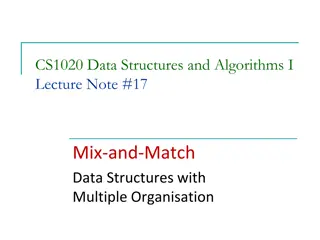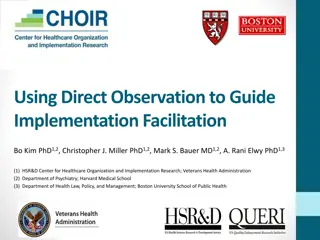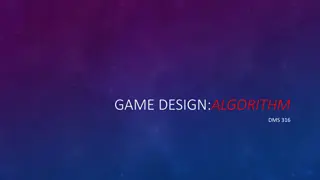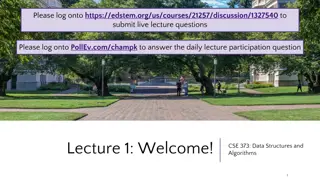Observation Study on Interactive E-book in Data Structures & Algorithms Course
An observation study was conducted on the use of an interactive e-book in a Data Structures and Algorithms course. The project members aimed to introduce active learning, continuous examination, and feedback by implementing an e-book with interactive examples, visualizations, exercises, automatic assessment, and immediate feedback. The study highlighted current challenges in courses, such as lack of practice, limited comprehensive assignments, and disconnected feedback. Comparisons were made between current e-textbooks and the proposed interactive e-book to enhance learning outcomes and overall course experience.
Download Presentation

Please find below an Image/Link to download the presentation.
The content on the website is provided AS IS for your information and personal use only. It may not be sold, licensed, or shared on other websites without obtaining consent from the author.If you encounter any issues during the download, it is possible that the publisher has removed the file from their server.
You are allowed to download the files provided on this website for personal or commercial use, subject to the condition that they are used lawfully. All files are the property of their respective owners.
The content on the website is provided AS IS for your information and personal use only. It may not be sold, licensed, or shared on other websites without obtaining consent from the author.
E N D
Presentation Transcript
An Observation Study on the Use of an Interactive e-book in a Data Structures and Algorithms Course CHUNYAN WANG, PATRICK LAMBRIX IDA
Project Members Tommy F rnqvist, IDA (PI) Fredrik Heintz, IDA Patrick Lambrix, IDA Linda Mannila, bo Akademi Chunyan Wang, IDA Pedagogiska spr nget 2014: Pedagogiska aspekter p inf randet av e-l romedel i datastruktur och algoritmkurs (all) PUG 2014 (Chunyan Wang) 2
Outline Motivation OpenDSA Observation Study Preliminary conclusions and future work 3
Outline Motivation OpenDSA Observation Study Preliminary conclusions and future work 4
Data Structures and Algorithms Study of basic building blocks in programming Abstract data types Sorting algorithms complexity Current courses Lectures, labs, exercise sessions Visualization of algorithms on course pages 5
Current courses Lack of practice Too few problems per topic Assignments aren t comprehensive Feedback Disconnected (received long after submission) Variable-quality (depends on grader) Sometimes none provided (especially if homework is optional) 6
Current E-textbooks Electronic versions of paper books Cheaper Easier to distribute Easier to access Content is static and identical to paper version No videos Not interactive Not updated 7
Goal Introduce active learning continuous examination and feedback in a data structures and algorithms course by using an e-book that provides interactive examples and visualizations many exercises automatic assessment and immediate feedback 8
Outline Motivation OpenDSA Observation Study Preliminary conclusions and future work 9
What is OpenDSA? E-book Textbook-quality text Interactive examples Randomly generated instances of exercises Provides much practice Provides automatic assessment and immediate feedback Web-accessible Free and open source 10
DEMO http://www.ida.liu.se/opendsa/OpenDSA/Books/TDDD86_ 2014/html/index.html 11
Project OpenDSA used in TDDD86 Data Structures, Algorithms, and Programming Language Paradigms 130 students from D and U programmes OpenDSA assigned for (extensive) homework and for (part of) exam Data collection Data logging by OpenDSA system Comparison of exam results to old course Questionnaires Observation study 12
Outline Motivation OpenDSA Observation Study Preliminary conclusions and future work 13
Method 6 students 2 observers 1 session = 25+5 minutes 3 sessions Complexity analysis Sorting Graphs 14
Questions (before) What are your expectations about this tool? Not carrying a book. Same as text book but modernized (e.g. interactive exercises). Makes me learn; Helps me learn. 15
Questions (before) What are your worries about this tool? None. Bugs. A lot of text. May guess the answers to questions. Student skips large parts of text and worries the exam may require students have read everything. 16
Questions (while) Usage of the tool at home vs the observation. Same. One student usually works together with another student (discussion, easier to remember). 17
Questions (while) When do you use the tool? Usually after the lecture. One student does several chapters at the same time. 18
Questions (while) Do you use any other materials? One student uses wikipedia as a complement. One student looked at other books in the beginning but found the tool to be better. 19
Questions (after) How do you feel about the tool? dictionary exercises (code) examples visualizations overviews/introductions 20
Questions (after) How do you feel about the tool? exercises Many, redo hints check answers, understanding. Even when you get the answers wrong, you still learn something. 21
Questions (after) How do you feel about the tool? mini-content pages; pop-up dictionary text format more links to refer to other parts in the book bugs Hard to focus on screen when getting tired 22
Questions (after) How do you feel about the tool? exercises Additional hints on where to read when answering wrong. Some exercises require doing similar things too often. Some exercises need a better explanation. 23
Questions (comparison) Difference with traditional course book. Exercises Reading Deeper learning Visualizations 24
Questions (comparison) Difference with traditional course book. Traditional Book On Line Tool Reading usually don t read books/don t like to read books have to read; active wouldn t read until before the exam throughout the course 25
Questions (comparison) Difference with traditional course book. Traditional Book On Line Tool Exercises skip exercises/do only some exercises do exercises (active=credits+interesing) do the exercises only before the exam do exercises throughout the course 26
Questions (comparison) Difference with traditional course book. Traditional Book On Line Tool Deeper learning ---- (Students think) deeper learning (use more senses) 27
Questions (comparison) Difference with traditional course book. Traditional Book On Line Tool Visualizations student would visualize with paper and pen, but would not be sure it is correct immediate feedback on correctness 28
Questions (study style) Did you change your way of using the tool? mainly guess the answers to the exercises spend more time on answering the questions in the exercises 29
Observation Aids Some students mark/mouse pointer to follow the text while reading. Several students adjust the screen. Some students use pen and paper, but several do not. 30
Observation Reading One student skims through the whole chapter to get an overview and then starts from the beginning. One student reads the whole text first and then does the exercises. Several students skip text. 31
Observation Others Dictionary is used a lot. Students like the code examples. (pseudo-code / Java) Visualizations and exercises (interactive parts of the tool) are appreciated and help understanding. 32
Observation Others Visualizations Some go back and forth between visualization and text/code. The students do not take the opportunity to run own examples with the visualizations. Some go very fast through some visualizations ( just clicking ). 33
Observation Others Exercises All use the hints. Different strategies to use the hints: Check all hints before answering. Only when answering wrong (not otherwise). After answering correct check remaining hints. Some students try to guess the answers; others go back and forth between exercise and text. Sometimes students just click on all possible answers ( takes too long to figure out ). 34
Outline Motivation OpenDSA Observation Study Preliminary conclusions and future work 35
Preliminary Conclusions Students prefer tool over traditional book. Dictionary, visualizations and exercises (interactive parts of the tool) are appreciated and help understanding. Makes students work during the course. Several students skip text. Guess answers to exercises; Interaction in the visualizations without learning. 36
Future Work Analyze the log data from openDSA and the questionnaire data (students and teachers). 37
Course web TDDD86 http://www.ida.liu.se/opendsa/OpenDSA/Books/TDDD86_2014 /html/index.html 39
